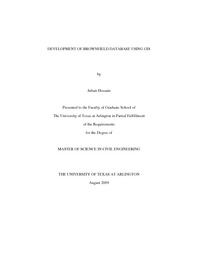
ATTENTION: The works hosted here are being migrated to a new repository that will consolidate resources, improve discoverability, and better show UTA's research impact on the global community. We will update authors as the migration progresses. Please see MavMatrix for more information.
Show simple item record
| dc.contributor.author | Hossain, Jubair | en_US |
| dc.date.accessioned | 2009-09-16T18:19:10Z | |
| dc.date.available | 2009-09-16T18:19:10Z | |
| dc.date.issued | 2009-09-16T18:19:10Z | |
| dc.date.submitted | January 2009 | en_US |
| dc.identifier.other | DISS-10325 | en_US |
| dc.identifier.uri | http://hdl.handle.net/10106/1746 | |
| dc.description.abstract | Brownfields are abandoned, idled or underutilized industrial or commercial sites where expansion or redevelopment is complicated by actual or perceived environmental contamination. Brownfields may be as small as a vacant city lot or as large as an abandoned manufacturing facility occupying several hundred acres. The extent of contamination encountered at brownfield sites may range from minor surface debris to extensive, dangerous soil and ground-water contamination. Concerning the communities in which brownfields are located, redevelopment may improve community appearance and image, relieve associated health and environmental concerns and produce a beneficial economic effect through increased property values and employment opportunities.The overall objective of the present work is to make a comprehensive database and to integrate a variety of GIS-based spatial analysis procedures to locate, map, classify and assess the current status of all the potential brownfield sites in the study area, Arlington, Texas. The database of the potential brownfield candidate sites was created from the listing of contaminated properties in different regulatory sources. The database was enriched and updated with information describing the current status of the brownfield site. All the potential brownfield sites were converted into GIS shape files based on their physical addresses. The focus of the current work was on the development of the brownfield database for three region of the City of Arlington: Central, East and Southwest. The brownfield sites (shape files) were classified according to the region and the regulatory sources. Brownfield sites under each region were divided based on the acreage of the property and further subdivided according to the vacancy. For the current work all the brownfield sites were divided under four ranges of areas: sites with area less than or equal to 0.5 acre, greater than 0.5 acre and less than or equal to 1.5 acre, greater than 1.5 acre and less than or equal to 5.0 acre and greater than 5.0 acre.All the features created in the ArcMap were converted into Google map using the ArcMap2GMap software which was developed by the GIS department of the University of Texas at Arlington. The purpose of the conversion of the ArcMap features into Google map was to create a user interface so that any person can see and query the database without having knowledge in GIS. | en_US |
| dc.description.sponsorship | Hossain, Sahadat | en_US |
| dc.language.iso | EN | en_US |
| dc.publisher | Civil & Environmental Engineering | en_US |
| dc.title | Development Of Brownfield Database Using GIS | en_US |
| dc.type | M.S. | en_US |
| dc.contributor.committeeChair | Hossain, Sahadat | en_US |
| dc.degree.department | Civil & Environmental Engineering | en_US |
| dc.degree.discipline | Civil & Environmental Engineering | en_US |
| dc.degree.grantor | University of Texas at Arlington | en_US |
| dc.degree.level | masters | en_US |
| dc.degree.name | M.S. | en_US |
| dc.identifier.externalLink | http://www.uta.edu/ra/real/editprofile.php?onlyview=1&pid=963 | |
| dc.identifier.externalLinkDescription | Link to Research Profiles | |
Files in this item
- Name:
- Hossain_uta_2502M_10325.pdf
- Size:
- 42.26Mb
- Format:
- PDF
This item appears in the following Collection(s)
Show simple item record


